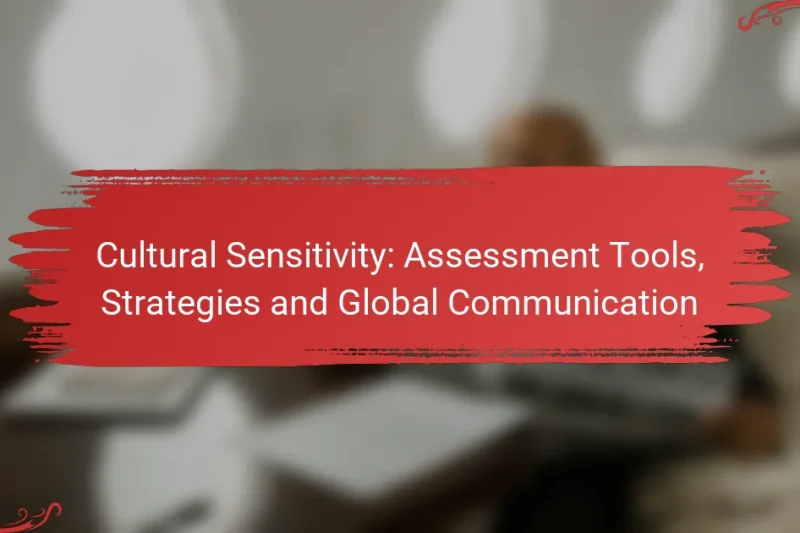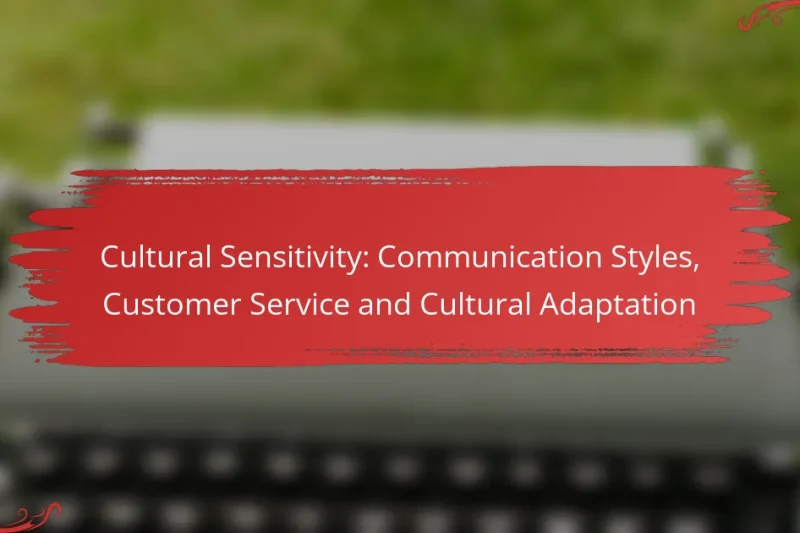Cultural sensitivity plays a crucial role in shaping brand reputation and market perception in Asia, where … Cultural Sensitivity: Brand Reputation, Market Perception and Consumer Trust in AsiaRead more
Cultural Sensitivity in Global Communication
Cultural sensitivity is essential for effective global communication, as it promotes respect and understanding among diverse groups. By appreciating cultural differences and adapting communication styles, individuals can enhance their interactions and minimize misunderstandings, leading to stronger relationships across cultures.
Cultural Sensitivity: Nuances in International Marketing, Campaign Effectiveness and Audience Engagement
Cultural sensitivity is crucial in international marketing, as it helps brands build stronger relationships with diverse … Cultural Sensitivity: Nuances in International Marketing, Campaign Effectiveness and Audience EngagementRead more
Cultural Sensitivity: Communication Strategies, Team Dynamics and Multinational Success
Cultural sensitivity is essential for enhancing team dynamics in multinational companies, as it promotes understanding and … Cultural Sensitivity: Communication Strategies, Team Dynamics and Multinational SuccessRead more
Cultural Sensitivity: Language Impact, Brand Messaging and Global Reach
Language plays a crucial role in cultural sensitivity, particularly in advertising, as it shapes how messages … Cultural Sensitivity: Language Impact, Brand Messaging and Global ReachRead more
Cultural Sensitivity: Assessment Tools, Strategies and Global Communication
Cultural sensitivity is essential for effective communication in our increasingly interconnected world. By utilizing assessment tools … Cultural Sensitivity: Assessment Tools, Strategies and Global CommunicationRead more
Cultural Sensitivity: Communication Styles, Customer Service and Cultural Adaptation
Cultural sensitivity in customer service is essential for fostering positive interactions and enhancing customer satisfaction across … Cultural Sensitivity: Communication Styles, Customer Service and Cultural AdaptationRead more
Cultural Sensitivity: Case Studies, Campaign Success and European Markets
Cultural sensitivity plays a crucial role in enhancing advertising effectiveness within European markets by aligning campaigns … Cultural Sensitivity: Case Studies, Campaign Success and European MarketsRead more
How can cultural sensitivity improve global communication?
Cultural sensitivity enhances global communication by fostering an environment of respect and understanding among diverse groups. By recognizing and valuing cultural differences, individuals can communicate more effectively and avoid misunderstandings.
Enhances mutual understanding
Mutual understanding is crucial in global communication, as it allows parties to appreciate each other’s perspectives. When individuals are culturally sensitive, they are more likely to listen actively and engage thoughtfully, leading to richer conversations.
For example, using culturally appropriate language and gestures can signal respect and openness, which encourages collaboration. This approach can be particularly beneficial in international business negotiations where cultural nuances can significantly impact outcomes.
Reduces miscommunication risks
Cultural sensitivity plays a vital role in minimizing miscommunication risks. By being aware of different communication styles and norms, individuals can avoid unintentional offenses or misinterpretations that may arise from cultural differences.
For instance, direct communication may be valued in some cultures, while others may prefer a more indirect approach. Understanding these preferences can help individuals tailor their messages appropriately, reducing the likelihood of confusion or conflict.
Builds stronger relationships
Building strong relationships across cultures is essential for successful global communication. Cultural sensitivity fosters trust and rapport, which are foundational elements in any relationship, personal or professional.
Engaging in culturally aware practices, such as acknowledging important local customs or holidays, can strengthen bonds. For example, a company that recognizes and celebrates local traditions in its international offices can create a more inclusive and cohesive work environment.
What are effective strategies for practicing cultural sensitivity?
Effective strategies for practicing cultural sensitivity include understanding and respecting the diverse cultural norms of others, actively listening during conversations, and adapting communication styles to fit the context. These approaches foster better relationships and minimize misunderstandings in global interactions.
Research cultural norms
Researching cultural norms is essential for effective communication across different cultures. This involves understanding values, beliefs, and social practices that shape how individuals interact. For example, in some cultures, direct eye contact is a sign of confidence, while in others, it may be perceived as disrespectful.
Utilize resources such as books, articles, and cultural training programs to gain insights into specific cultural practices. Engaging with local communities or cultural organizations can also provide valuable firsthand knowledge.
Engage in active listening
Active listening is crucial for demonstrating cultural sensitivity. This means fully concentrating on the speaker, understanding their message, and responding thoughtfully. Techniques such as nodding, summarizing what has been said, and asking clarifying questions can enhance this process.
Be aware of non-verbal cues that may differ across cultures. For instance, silence can indicate contemplation in some cultures, while in others, it may signal discomfort. Adjust your listening approach based on these cultural nuances to foster better communication.
Adapt communication styles
Adapting communication styles to suit different cultural contexts can significantly improve interactions. This may involve modifying your tone, pace, or choice of words to align with the expectations of the other party. For example, a more formal approach may be necessary in hierarchical cultures, while a casual style may be appreciated in egalitarian settings.
Consider the use of idioms or colloquialisms, as these may not translate well across cultures. Instead, aim for clear and straightforward language to avoid misinterpretations. Regularly seek feedback on your communication style to ensure it resonates well with diverse audiences.
What role does language play in cultural sensitivity?
Language is a fundamental component of cultural sensitivity, as it shapes how individuals express ideas, emotions, and values. Understanding the nuances of language helps avoid misunderstandings and fosters respectful communication across diverse cultures.
Language nuances affect meaning
Subtle differences in language can significantly alter the intended message. For instance, idiomatic expressions may not translate directly, leading to confusion or offense. It’s essential to be aware of these nuances to convey respect and understanding.
Consider the phrase “kick the bucket,” which means to die in English. In cultures unfamiliar with this idiom, the literal interpretation could lead to misunderstandings. Always aim for clarity and consider the cultural context when choosing words.
Translation accuracy is crucial
Accurate translation is vital for effective communication in a global context. Misinterpretations can result in miscommunication, which may damage relationships or create conflict. Employing professional translators familiar with cultural contexts can enhance accuracy.
When translating important documents or marketing materials, ensure that the translation captures not just the words but also the intended tone and cultural significance. This approach minimizes the risk of errors that could lead to negative perceptions.
Use of local dialects fosters connection
Incorporating local dialects into communication can create a sense of familiarity and trust. Using regional expressions or terminology shows respect for the local culture and can strengthen relationships. It signals that you value the audience’s identity and heritage.
For example, using “cheers” in British English or “gracias” in Spanish can resonate more with local audiences than generic terms. However, be cautious; using dialects incorrectly can have the opposite effect and may come off as insincere or patronizing.
How can businesses implement cultural sensitivity training?
Businesses can implement cultural sensitivity training by developing programs that address the specific cultural contexts of their employees and clients. This training should focus on enhancing awareness and understanding of diverse cultural practices and values to improve communication and collaboration.
Develop tailored training programs
Creating tailored training programs involves assessing the unique cultural dynamics of the workforce and the markets served. Companies should consider factors such as the cultural backgrounds of employees, the geographic locations of operations, and the demographics of the customer base.
For example, a company operating in both the U.S. and Japan might develop separate modules focusing on American directness versus Japanese indirect communication styles. This approach ensures that the training is relevant and impactful for all participants.
Incorporate real-world scenarios
Incorporating real-world scenarios into training helps employees relate to and understand cultural sensitivity in practical terms. Role-playing exercises or case studies can illustrate potential cultural misunderstandings and effective resolution strategies.
For instance, a scenario might involve a team meeting where differing cultural norms around hierarchy and decision-making could lead to conflict. Discussing these situations prepares employees to navigate similar challenges in their work environments.
Evaluate training effectiveness
Evaluating the effectiveness of cultural sensitivity training is crucial for ensuring its impact. Businesses should gather feedback through surveys, interviews, or assessments to measure changes in employee attitudes and behaviors regarding cultural interactions.
Setting specific goals, such as improved team collaboration or reduced misunderstandings in cross-cultural communications, can help gauge success. Regularly revisiting and updating training materials based on evaluation results keeps the programs relevant and effective over time.
What are the challenges of cultural sensitivity in communication?
Cultural sensitivity in communication involves recognizing and respecting the diverse backgrounds and values of individuals. Key challenges include overcoming stereotypes, addressing language barriers, and managing diverse perspectives, all of which can hinder effective interaction.
Overcoming stereotypes
Stereotypes can lead to misunderstandings and reinforce biases in communication. To overcome them, individuals should approach conversations with an open mind and avoid making assumptions based on cultural backgrounds.
Engaging in active listening and asking open-ended questions can help clarify intentions and foster a more inclusive dialogue. For example, instead of assuming a person’s opinion based on their nationality, inquire about their unique experiences and viewpoints.
Addressing language barriers
Language barriers can significantly impede effective communication. To address these challenges, consider using clear and simple language, avoiding idioms or jargon that may not translate well across cultures.
Utilizing translation tools or hiring interpreters can also enhance understanding. When possible, encourage participants to speak in their preferred language, which can lead to more authentic exchanges.
Managing diverse perspectives
Managing diverse perspectives requires acknowledging that individuals may interpret messages differently based on their cultural contexts. It is essential to create an environment where all voices are heard and valued.
Facilitating discussions that encourage sharing of different viewpoints can enrich conversations. Employing techniques such as round-table discussions or feedback sessions can help ensure that everyone has the opportunity to contribute and feel respected.
How does cultural sensitivity impact marketing strategies?
Cultural sensitivity significantly influences marketing strategies by ensuring that messages resonate with diverse audiences. Understanding local customs, values, and preferences allows brands to tailor their campaigns effectively, fostering deeper connections with consumers.
Enhances brand reputation
Being culturally sensitive helps build a positive brand reputation. Companies that respect local traditions and values are often viewed more favorably, which can lead to increased trust among consumers. For instance, brands that celebrate local holidays or support community initiatives can enhance their image and loyalty.
Conversely, cultural insensitivity can lead to backlash and damage a brand’s reputation. Avoiding stereotypes and offensive imagery is crucial to maintaining a strong public perception.
Increases customer engagement
Cultural sensitivity can significantly boost customer engagement by making marketing messages more relatable. When brands reflect the cultural nuances of their target audience, they are more likely to capture attention and encourage interaction. For example, using local languages and symbols in advertising can create a sense of belonging among consumers.
Engagement can also be enhanced through community involvement and feedback. Brands that actively listen to their audience and adapt their strategies accordingly often see higher levels of participation and loyalty.
Improves campaign effectiveness
Marketing campaigns that incorporate cultural sensitivity tend to be more effective in achieving their goals. Tailoring content to align with local values and preferences can lead to higher conversion rates and customer satisfaction. For instance, a campaign that highlights local influencers or cultural icons can resonate more deeply with the audience.
To maximize effectiveness, brands should conduct thorough market research to understand cultural contexts. This may involve focus groups or surveys to gauge consumer reactions to proposed campaigns, ensuring that messaging aligns with local expectations and norms.






